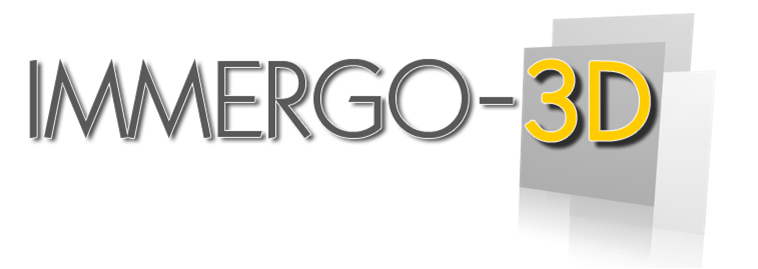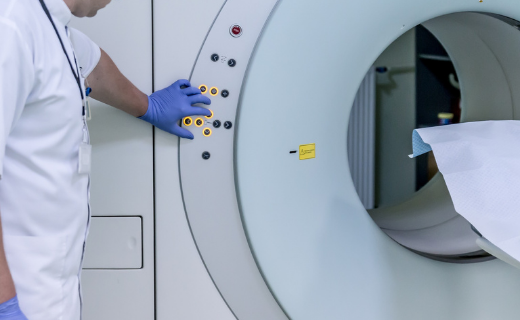
3D-oriented & GPU-based Multimodal Medical Imaging Processing and Rendering System

The IMMERGO-3D project applies Information Technology to develop new technologies to increase the effectiveness and efficiency of software systems to support computer-aided diagnostic (Computer-Aided Diagnosis – CAD) based on analysis of volumetric images acquired by Magnetic Resonance Imaging (MRI), ultrasound (U.S.) and computerized tomography (CT).
THE PROJECT
The project aims to exploit adequately the capabilities of GPUs to overcome the limitations of current CAD systems by developing techniques for identification of anatomical structures based on real-time interaction with the doctor who performs the diagnostic procedure. Unlike conventional CAD systems, where the medical knowledge is exploited mainly to validate the final result of (semi)automatic techniques, this approach allows to reverse the operational paradigm, because the parameters that govern the process of segmentation and recognition are adjusted interactively, with an immediate and analogous reactive interaction, similarly to the adjustment of brightness and contrast of a normal television screen. The immediate visual assessment of the effect of regulation should allow to converge faster to the optimal solution. The improvement of the processing time and response (and therefore reporting) also represents a considerable evolution at the clinical level, since the added value of a diagnosis obtained with the help of CAD systems is sometimes regarded as insufficient to justify the increase of time required by the step of calculation and validation of the results.
The project involves design and experimental development of modules characterized by open technologies adapted to different types of data and support the typical workflow of CAD systems by optimizing the following aspects:
- calculation speed of segmentation (such as to allow a closed-loop interaction with an operator);
- interactive identification of anatomic structures of interest;
- three-dimensional visualization of anatomical structures by means of semi-immersive virtual reality.
RESEARCH AREA
The project aims to exploit adequately the capabilities of GPUs to overcome the limitations of current CAD systems by developing techniques for identification of anatomical structures based on real-time interaction with the doctor who performs the diagnostic procedure. Unlike conventional CAD systems, where the medical knowledge is exploited mainly to validate the final result of (semi)automatic techniques, this approach allows to reverse the operational paradigm, because the parameters that govern the process of segmentation and recognition are adjusted interactively, with an immediate and analogous reactive interaction, similarly to the adjustment of brightness and contrast of a normal television screen. The immediate visual assessment of the effect of regulation should allow to converge faster to the optimal solution. The improvement of the processing time and response (and therefore reporting) also represents a considerable evolution at the clinical level, since the added value of a diagnosis obtained with the help of CAD systems is sometimes regarded as insufficient to justify the increase of time required by the step of calculation and validation of the results.
The project involves design and experimental development of modules characterized by open technologies adapted to different types of data and support the typical workflow of CAD systems by optimizing the following aspects:
- calculation speed of segmentation (such as to allow a closed-loop interaction with an operator);
- interactive identification of anatomic structures of interest;
- three-dimensional visualization of anatomical structures by means of semi-immersive virtual reality.
The setting of the segmentation process designed by the project makes use of processing techniques and real-time interaction made particularly attractive by the adoption of consumer technology for high-performance computing and low cost, helping to deliver a marketable product at competitive prices and final cost beneficial for the average user, with possible repercussions on existing product portfolios.
The use of the techniques of GPU computing is consistent with the current technological trends that require a greater use of graphics hardware to increase computing power and rendering, especially in optical 3D. GPU-based processing techniques – developed in world-famous research centers – are already used for example in more recent versions of Internet browsers and in photo and video editing tools. According to recent market analysis, the computing power of graphics cards are already considerably higher than those of modern processors, with a growing trend. The project fits well in a particularly favorable moment of technology take-up, considering the complete maturation of the solutions considered and the project schedule, with possible market launch of the first derivatives.
The full realization of the project will be achieved through the following objectives:
- study of a number of families of segmentation and recognition techniques suitable for a number of relevant diagnostic problems and with a computational structure appropriate to a highly parallel implementation (such families will have to be specialized to address the various problems specific diagnostic);
- development of a software platform that enables the deployment of intermediate GPU families of techniques identified (the platform will provide services and tools to specialize and apply the techniques to identify diagnostic problems of interest);
- study and realization of human-machine interaction module based on 3D visualization to allow the operator to control the operation of the closed-loop segmentation techniques adopted;
- development of a demonstrator for a few specialized areas of application selected and validated in a clinical setting realistic with the support of an entity Hospital.
CONSORTIUM
A consolidated research group with a renowned academic and industrial profile.
- algoWatt SpA (IT)
- Camelot Srl (IT)
- University of Genoa – Department of Computer and Information Science – VICOLAB (IT)
- E.O. Ospedali Galliera – Radiological Area Department (IT)

